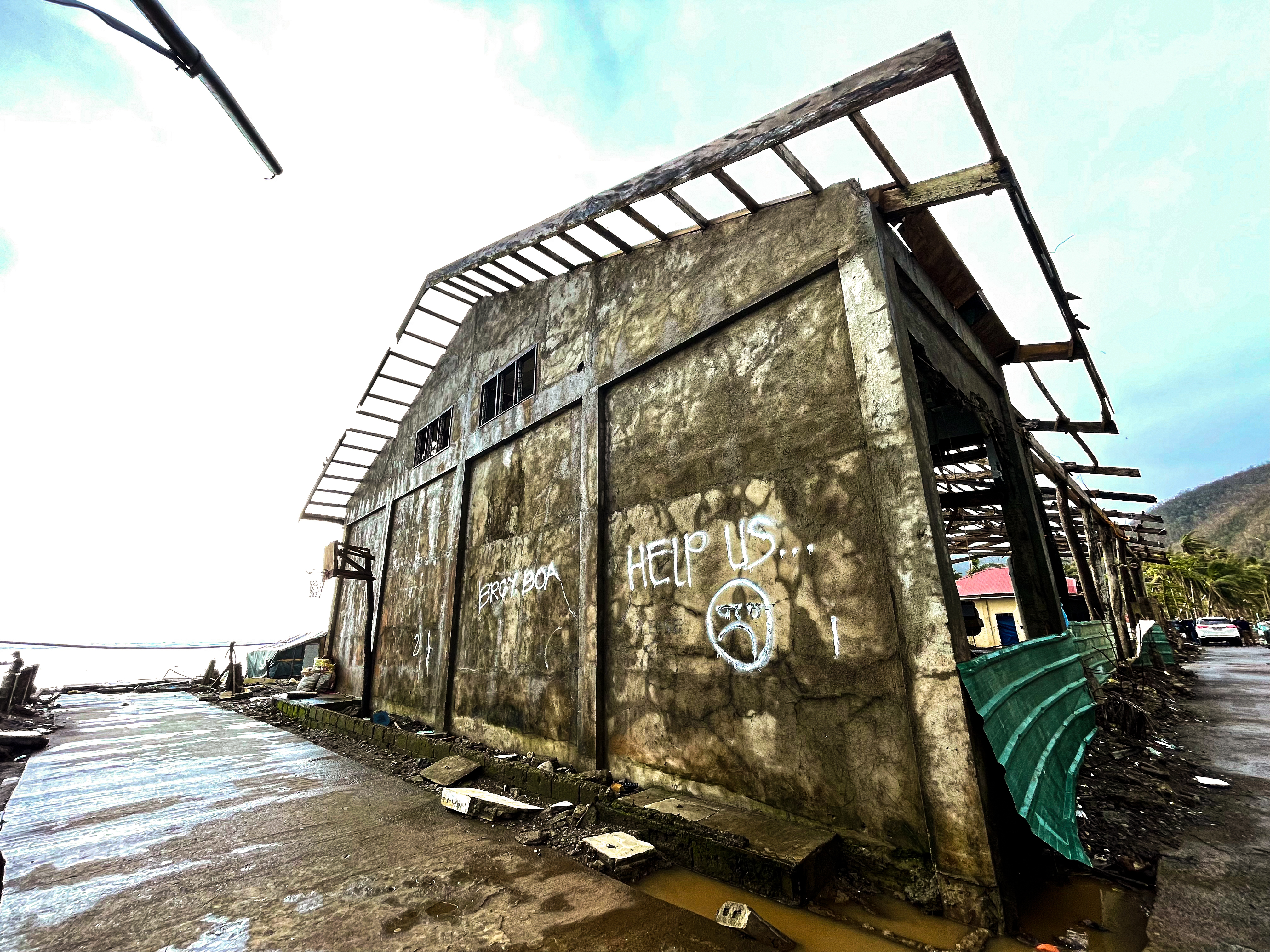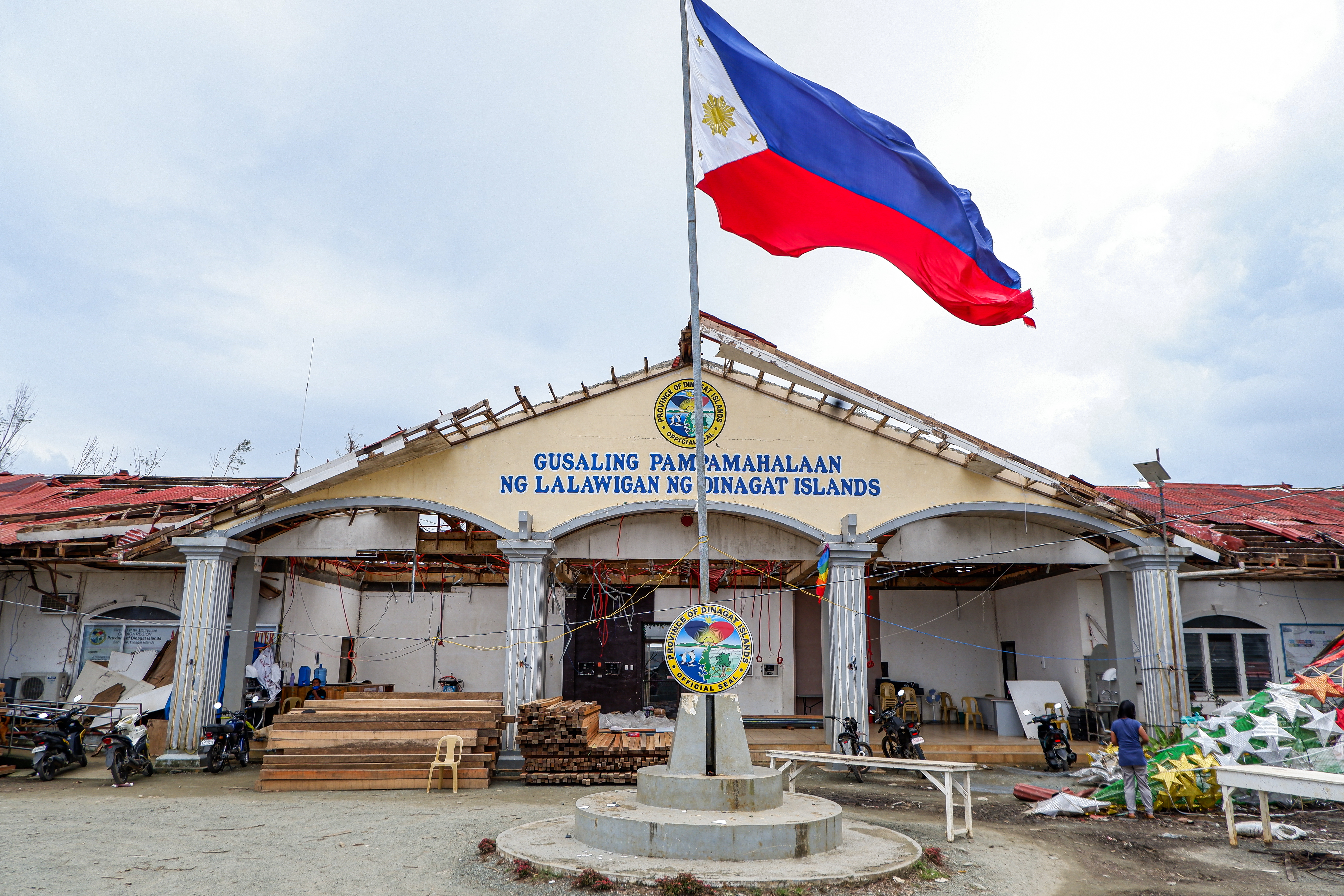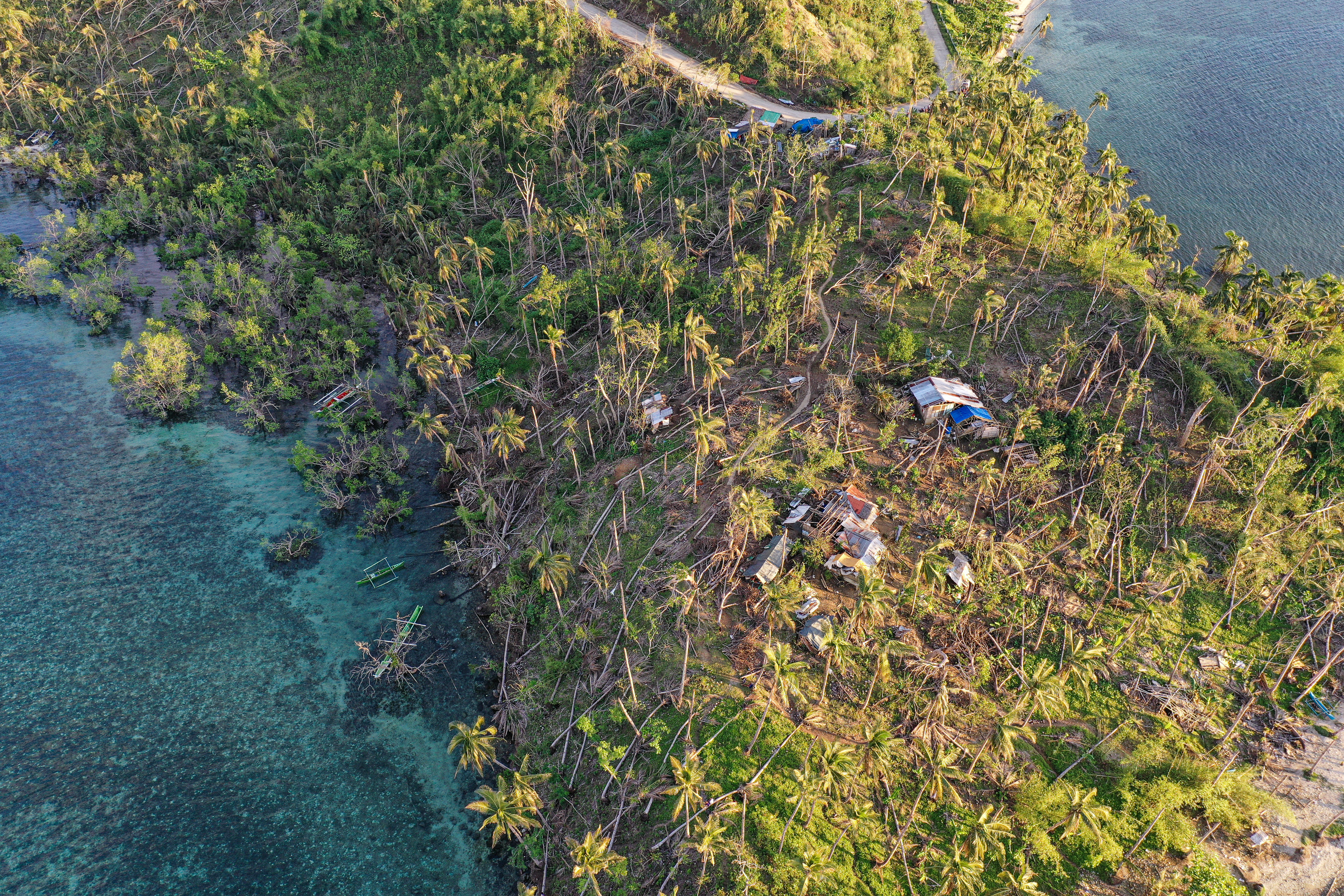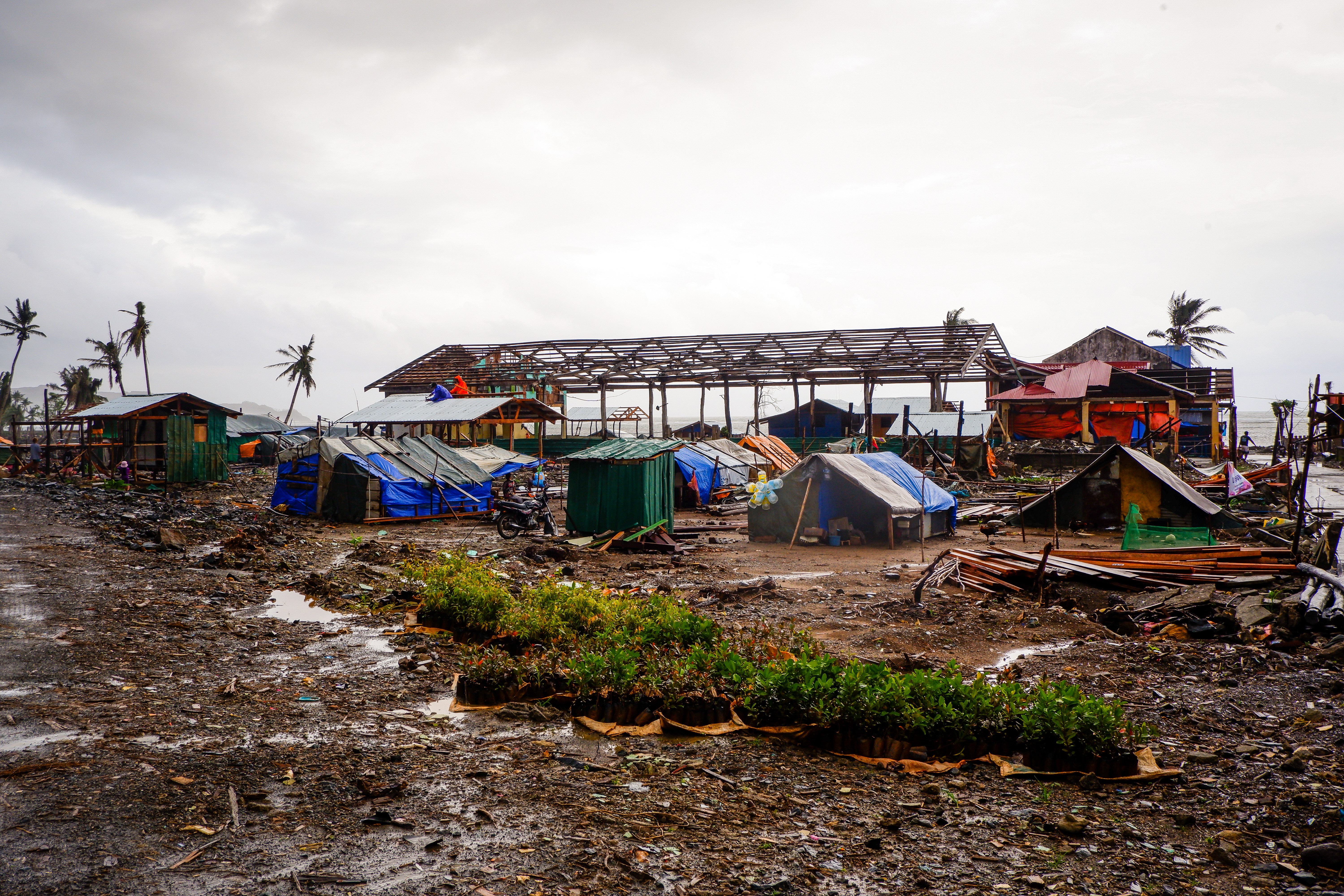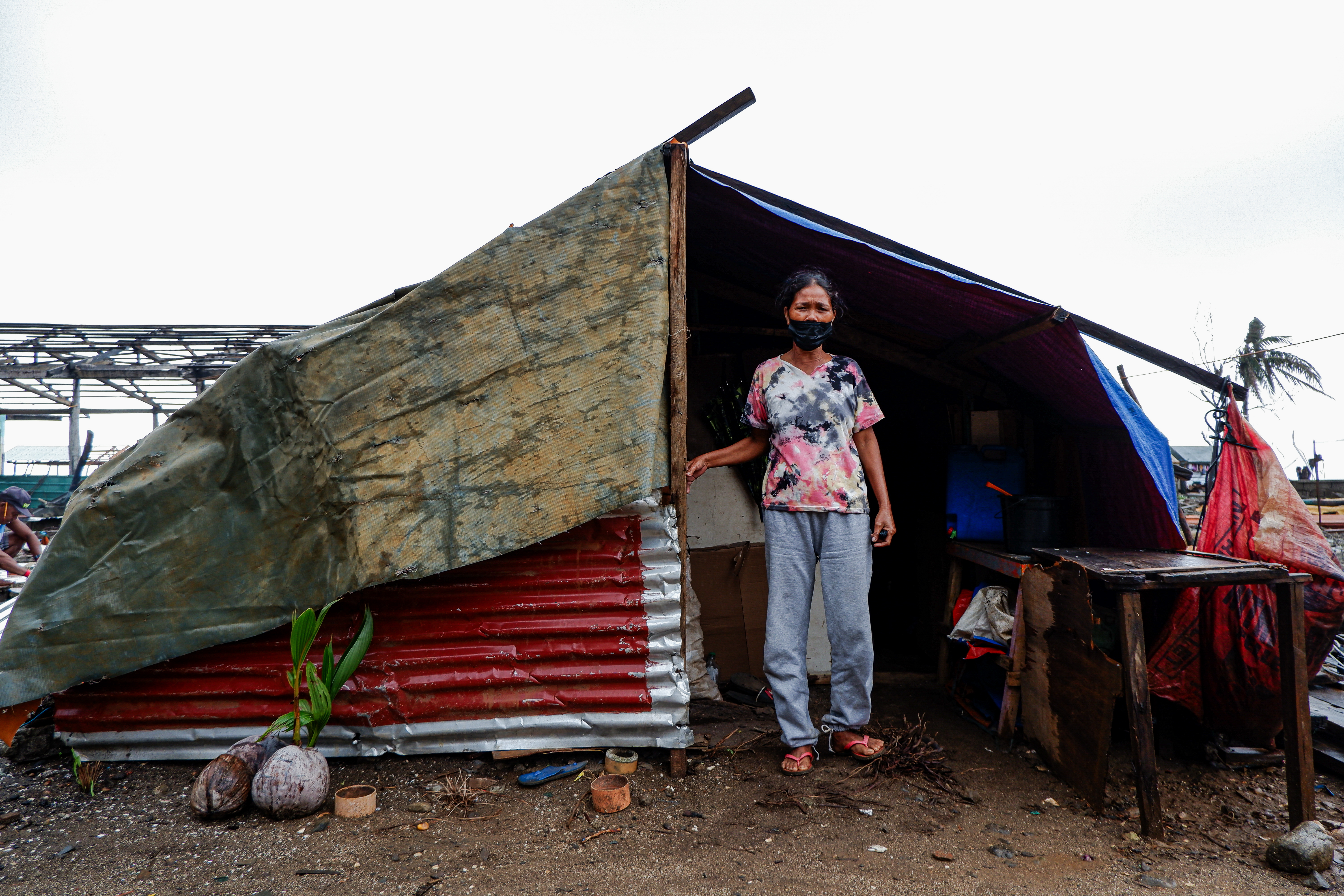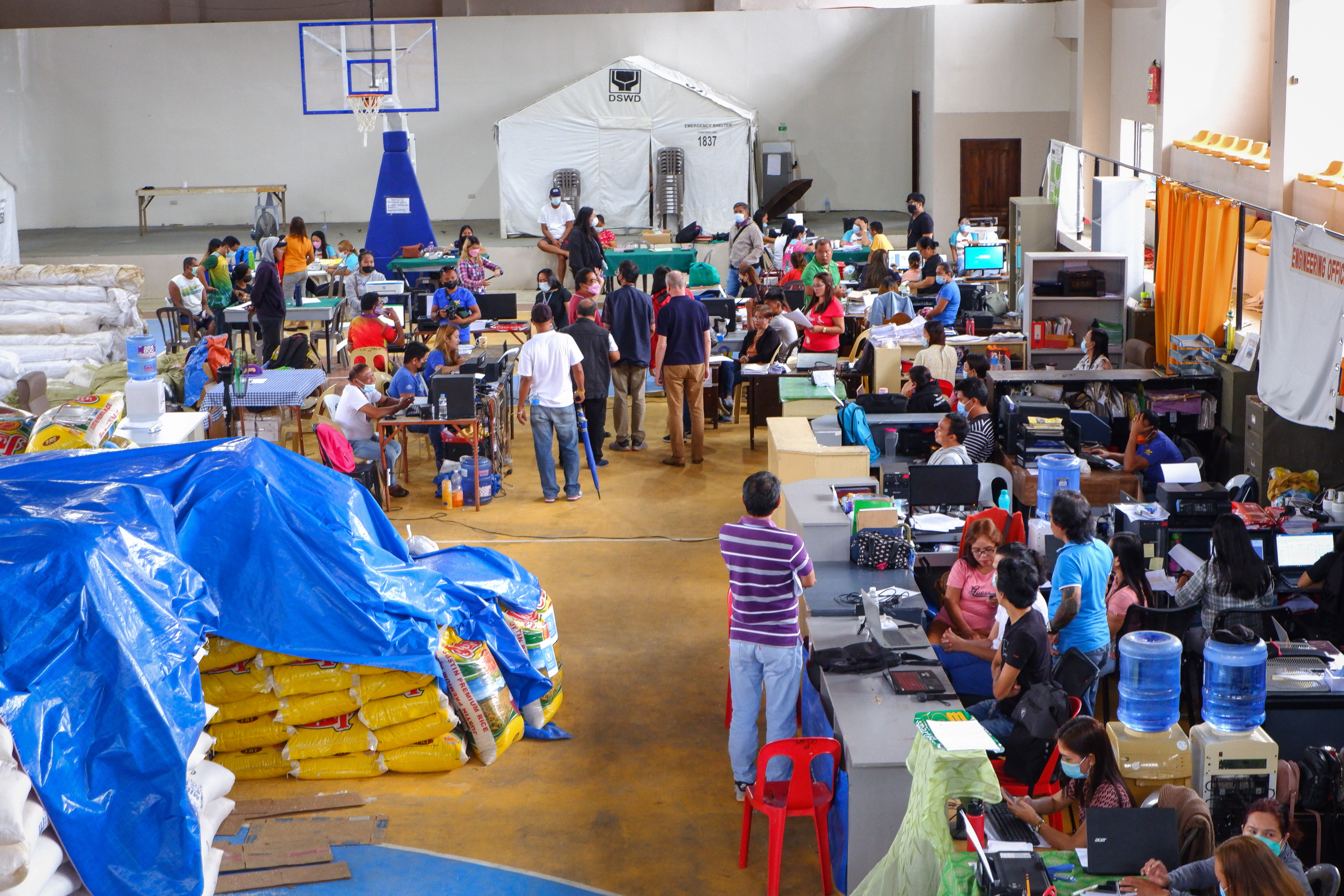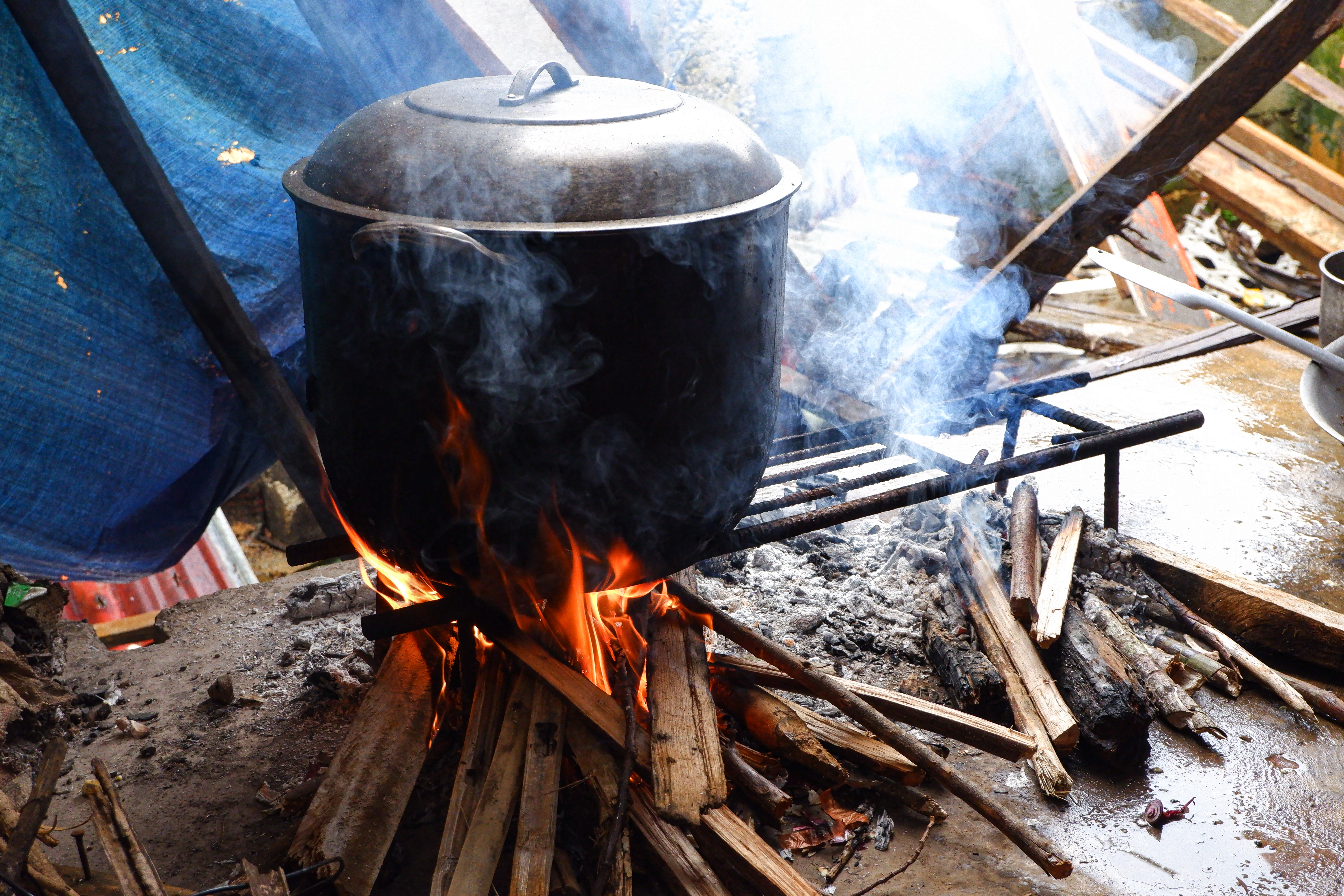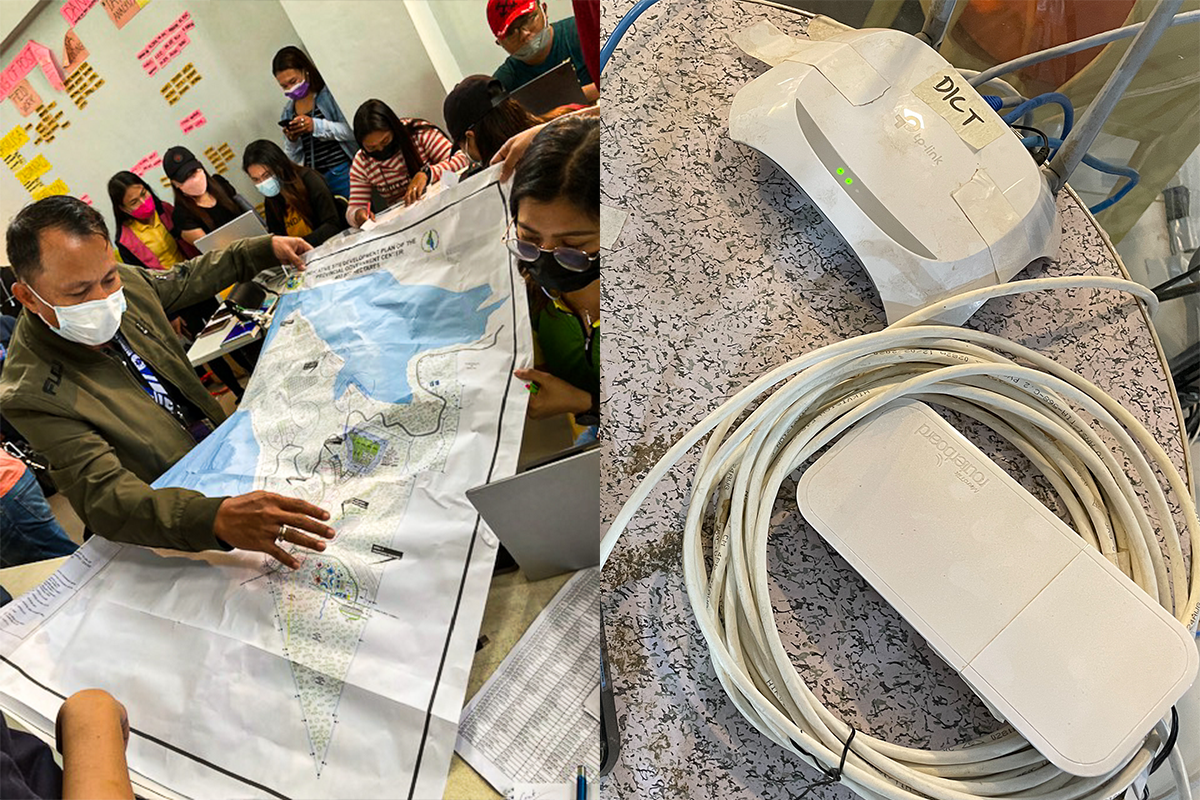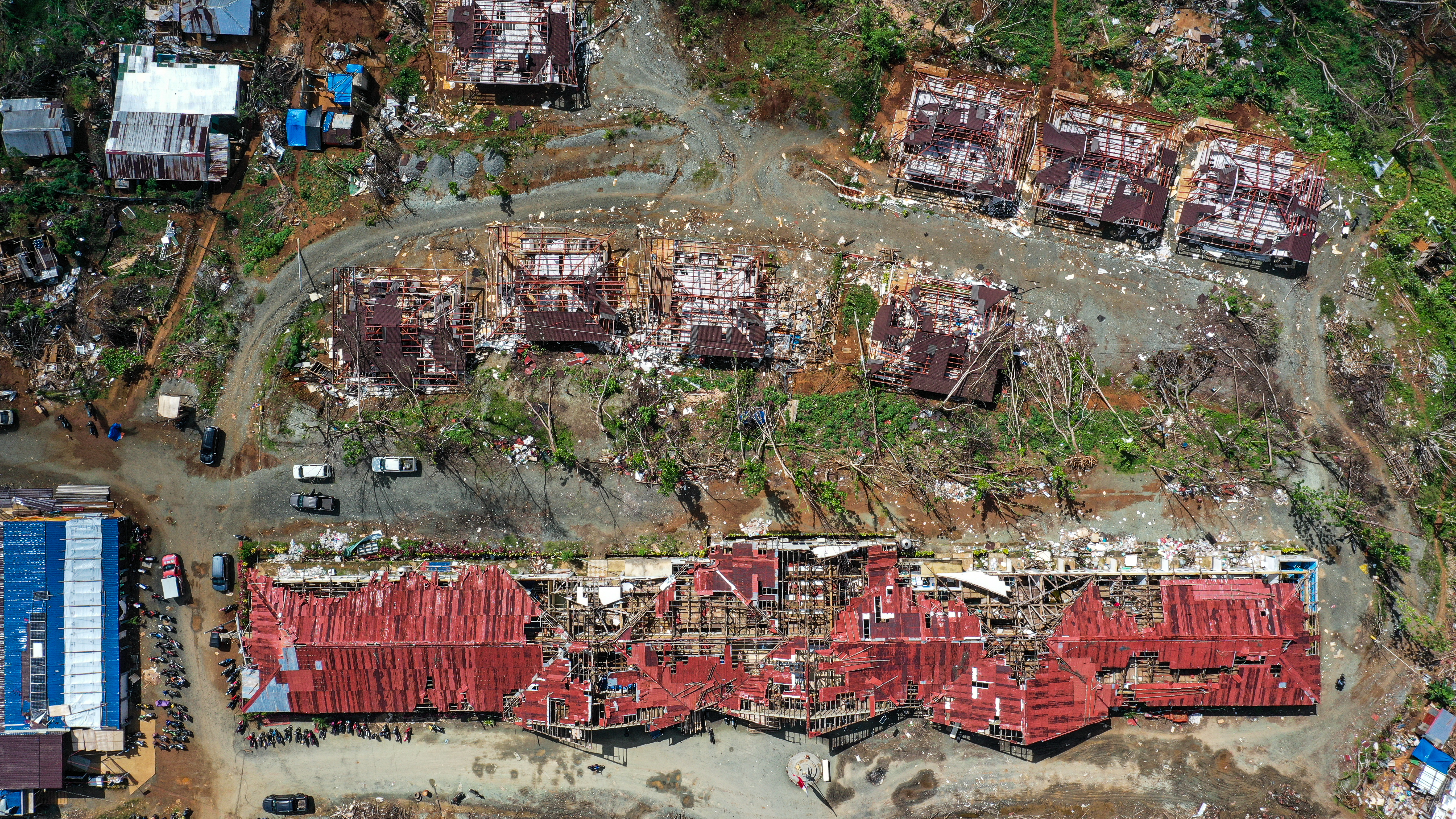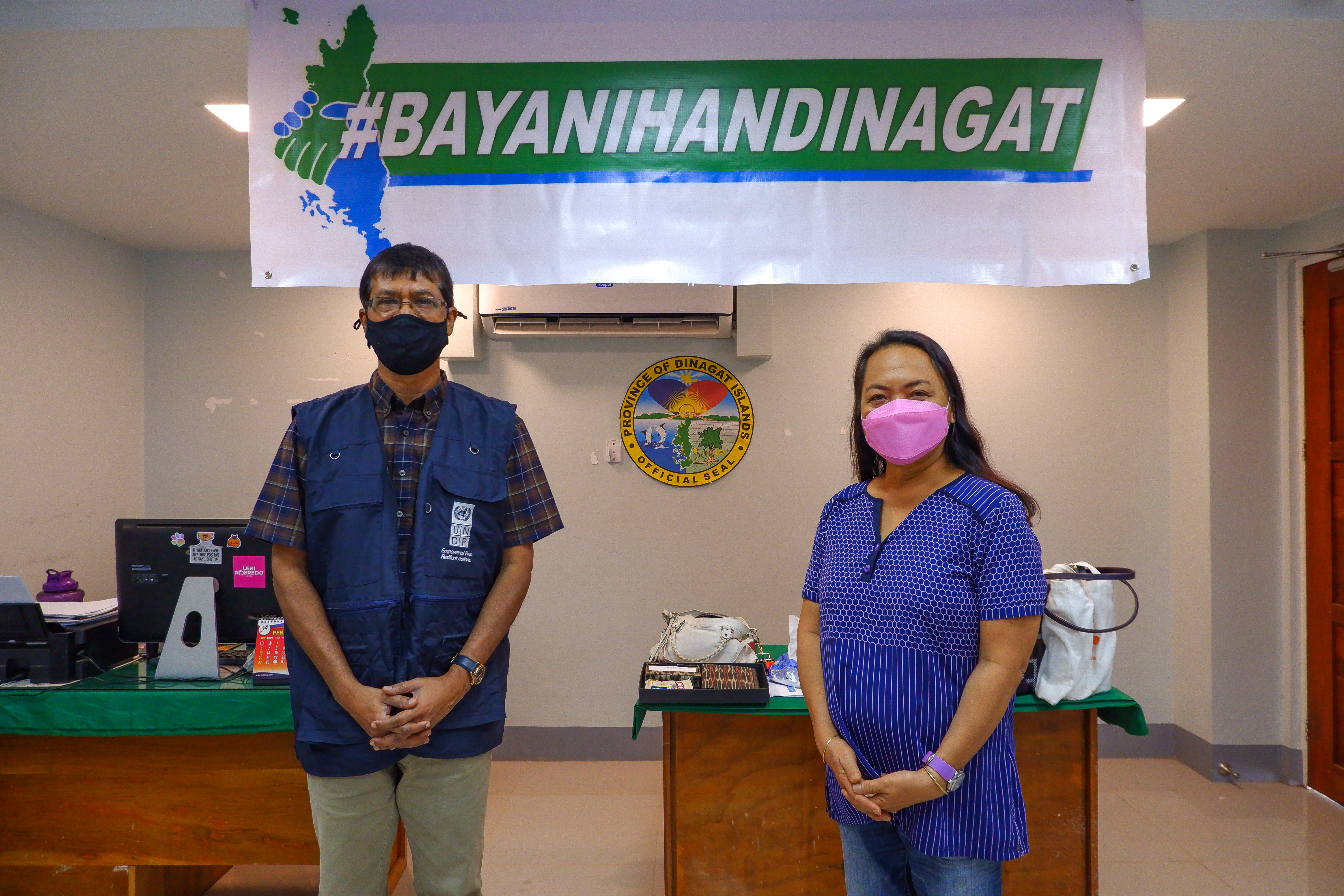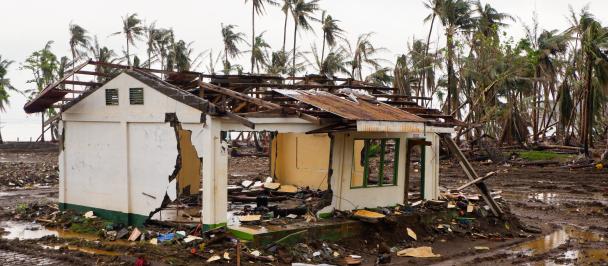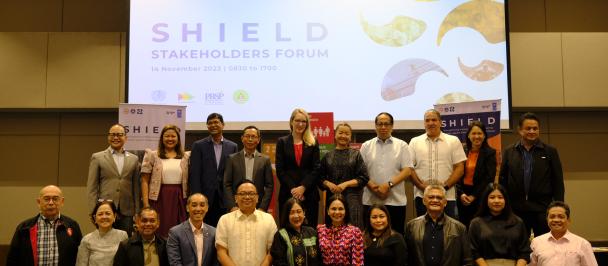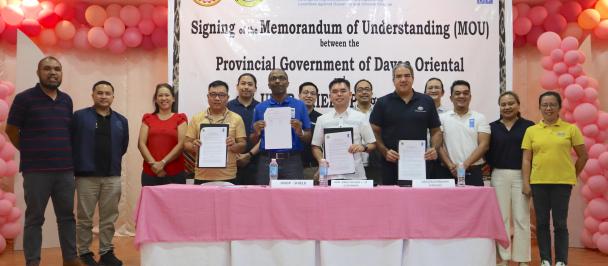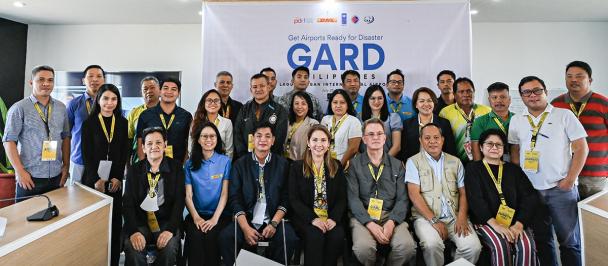By Selva Ramachandran, Resident Representative & Remelizza Joy Sacra-Dejucos, Communication Consultant
Typhoon Odette’s Catastrophe: The Case of Dinagat Islands Province
March 7, 2022
Residents of Barangay Boa in the municipality of Cagdianao, Dinagat Islands Province painted the wall of the ruins of their covered court plaza, pleading for help in the aftermath of Typhoon Odette/Rai.
Early in February, the northeasterlies continued to bring rain showers in eastern Mindanao, especially the provinces facing the Pacific. But the swell - those large blankets of waves, which the CARAGA region is famous for - was rather calm. The boat crew said that the usual three-hour travel from the Surigao City port to Dinagat Islands can be reduced into two and half hours – a good sign that we might be able to reach the islands before dusk from the long journey from Manila. The cargo boat was packed with vehicles, agriculture and food supplies, humanitarian aid, and passengers. The residents of Dinagat Islands had heard that the electricity in some parts of the province has finally been restored. For families that have sought shelter among relatives in Surigao City and nearby towns after the onslaught of Typhoon Odette, despite a slow recovery, it was a homecoming.
Or was it really?
In mid-December 2021, Typhoon Odette (internationally named Rai) struck the Philippines, and brought extensive damages and losses in at least 7 provinces, affecting more than 16 million people. The much improved early warning system led to lower number of casualties reported. However, Typhoon Odette caused widespread and severe damage to a variety of critical infrastructure and socio-economic sectors, thus disrupting the ability of local governments to provide essential services.
Given the scale of challenges, the focus of the typhoon response is picking up pace and will still need a strong humanitarian angle until June 2022.
The Island Province of Dinagat
The Provincial Capitol of Dinagat Islands suffered severe damage when Typhoon Odette hits the province last December 16, 2021. To these days, the provincial government is operating in makeshift operation centers and offices. Photo by Camille Soriano/UNDP Philippines
The Province of Dinagat Islands was one of the areas worst-hit areas by Typhoon Odette.- the third Category 5 typhoon to hit the country in the last two years. It affected over 34,000 families in the Dinagat alone and left more than 14,500 houses totally destroyed and another 15,700 partially damaged. The province depends on agriculture, fishing, and mining as the key sources of economy and employment. The province incurred over PhP 1.1 billion (USD 21.4 million) worth of agricultural damage and approximately PhP 2.8 billion (USD 54.6 million) damage to infrastructure and utilities. Over 8,000 fishing boats were totally damaged, leaving fisherfolks unable to go to the sea. Similarly, an estimated 1.4 million coconut trees were destroyed with the risk of infestation if not cleared quickly. Farmers who depended on copra production lost their main source of livelihood.
Coconut is one of the main livelihoods of people in Dinagat Islands. The coconut farmers, who were already marginalized even before the typhoon, sustained heavy and long-term damage in their economic activity. Photo by Rex Lor/UNDP Philippines
According to locals, a few hours after noon on December 16, 2021, they started to experience heavy rain and strong winds. At exactly 3:10 in the afternoon, Typhoon Odette made landfall in the coastal municipality of Cagdianao. There was creeping silence that lasted for about 15 minutes when the center of the eye of the typhoon crossed the island. Then, the residents braced for the worst part. For the next three hours, the entire province was battered with heavy rains and torrential wind. In Barangay Boa, several meters high storm surges almost wiped out the entire village.
Facing the Pacific Coast, the community center of Barangay Boa was almost wiped out by large waves during the typhoon. What remains are ruins of houses, daycare centers, and covered plaza. People have set-up temporary shelters from old tarpaulin to protect their families from continuous rain.
Nosen Gabradilla and her husband live in one of the makeshift shelters in the coastal village of Boa.
Boa has become a ‘tent city’ for residents who chose to build their temporary shelter out of tarpaulins and plywood on the same ground that was wiped out by the storm surge. Nosen Gabradilla was one of the residents whose house was totally damaged. A member of Palaw’an tribe, she was just visiting her husband’s family in Barangay Boa in early 2020 when the COVID-19 pandemic came. They were stranded in Boa, and, with nowhere to go, decided to build a modest home near the sea, while her husband tried to earn money from fishing. Nosen and her husband were looking forward to going back to the Palawan province last December after having saved around PhP 20,000(USD 390), but in a matter of hours large waves swept their home, including their money, which they kept in a bag under their bed. Running to safety, with almost no cover, Nosen was not able salvage anything from their home, but herself and the clothes on their back. When asked why they did not put their savings in the bank, Nosen said that they did not know how to open one. There was no bank or any financial institution near the barangay. She does not even have a birth certificate because she was born an IP. She was not sure about her birth date.
Comprised of both men and women fishers, this is a production line for bottled fish in the municipality of Libjo prior to the typhoon. File photo from Provincial Government of Dinagat Islands
In the coastal municipality of Libjo, the Sidlak Magsaysay Consumers Cooperative (SMCC) bottled fish production was also wiped out. The facility, equipment, and boats that were being used for fishing and production were damaged, logging approximately PhP 1.5 million (US$ 30,000) in losses. Last year, the SMCC received support from the province, the Bureau of Fisheries and Aquatic Resources, and the Department of Trade and Industry to start the production and processing of scad in corn oil and tomato sauce since it is abundant in the area. The bottled fish production is the bread and butter of women fishers, especially during closed season, when fishing is not allowed. From September to November 2021 alone, the cooperative produced 2,300 bottles worth PhP 264,500 pesos. Each bottle was being sold at PhP 115. Their product was ready for accreditation by the Food and Drug Administration, an extraordinary feat for a community-based organization. But today, the cooperative and its women members are back to square one with all the damages incurred due to Typhoon Odette.
Heavy rain continued to loom over the islands two months after the typhoon. The compounded impact of the typhoon and the COVID-19 pandemic has exacerbated the living condition of many Dinagat residents. Dinagat Islands belong to one of the poorest regions in the country and are considered as one of the most geographically isolated and disadvantaged areas. According to the Philippines Statistics Authority, its poverty incidence is at 30.3% as of first half of 2021, which means that almost one-third of its population is living below the poverty line.
The loss of opportunities due to restriction in mobility during the pandemic and the loss of livelihood after the typhoon aggravated even further the marginalized sectors, including farmers, fishers, and small entrepreneurs.
With their municipal halls almost totally damaged, the municipal local government of Dinagat Island is using their covered court plaza to ensure that frontline government services will remain operational.
In the wake of Odette, the provincial and municipal local government units continued to deliver essential services from make-shift offices and operation centers. In the LGU of Dinagat, the municipal hall buildings were heavily damaged. The LGU staff tried to save old documents including court records and evidence. They converted the town’s covered plaza into a makeshift coordination center and triage for frontline services, repacking of relief goods, and emergency operations. Barangay halls were also converted to community kitchens.
The community kitchen of New Mabuhay uses a traditional method of cooking in wood and iron-stand to serve hot porridge to children and elderly in their village.
“We rely on the provincial government’s subsidy for our community kitchen. It has been running since day one after the typhoon hit us. At least once a day, we provide hot porridge to community members. We prioritize children and elderlies. We have 17 barangay health workers who shift rotation – both to attend to the community kitchen and perform pandemic duties,” said Josefa Asuncion, one of the barangay counselors in New Mabuhay, Dinagat Island.
The only unit of satellite WiFi being used by the Provincial Government of Dinagat Islands in their operation center.
To connect to the internet, the entire province heavily relies on one unit of satellite Wi-Fi deployed by the Department of Information and Communication Technology. This sole satellite Wi-Fi unit connects the provincial operation center of Dinagat Islands to the national government, humanitarian organizations, and other key development partners to ensure that information necessary to facilitate the delivery of aid will reach the agencies.
Recovery and Resilience from Day 1 of Response
The Provincial Government compound of Dinagat islands in the aftermath of Typhoon Odette/Rai. Photo by Rex Lor/UNDP Philippines
For a country faced with recurring crises, particularly due to extreme weather events, collective thinking and subsequent action that combine life-saving and life sustaining are warranted to help the people build back. Losses and damages due to Typhoon Odette are proof that extreme weather events are increasingly becoming more frequent at an unacceptable rate, which peaked at 4% of the GDP in 2013 due to Super Typhoon Haiyan.
To break the cycle of crises, recovery and resilience ought to be part of the response plans and should go hand-in-hand with humanitarian action from day one. There should be an emphasis on a) reducing or eliminating avoidable deaths from multiple shocks; b) support in restoring and saving livelihood assets; and c) restoration of critical services and improve access of affected population to have a continuum on sustainable development.
Noting the increasing difficulty of attaining fast and timely recovery, it is apparent that the loss and damage impacts of these climate events are outstripping the country’s capacity to withstand climate shock - a realization stated in the Philippines Nationally Determined Contribution (2021). Despite the efforts of the Philippine government and other development agencies to invest in structural and non-structural disaster risk reduction measures, the severity of damages of Typhoon Odette exposed that infrastructures and communities are still highly vulnerable in relation to historical weather events such as those that have occurred within statistical records. At the local levels, the insufficient ability of people and communities to bounce back and return to the pathway of normalcy is observed to be very slow, especially in remote island municipalities and provinces like Dinagat.
UNDP Philippine Resident Representative Selva Ramachandran and Dinagat Islands Governor Arlene “Kaka" Bag-ao discussed the priority support needed by the Province and how UNDP can respond and support in its long-term recovery and resilience.
The Post Disaster Needs Assessment (PDNA) of Typhoon Odette is expected to be released by end of March 2022 with a several billions of budget tag. A collective approach from the government, CSOs, the private sector and development partners is needed to support the recovery and rehabilitation effort. It is an opportunity for UNDP to implement the transformational agenda with the refreshed approach to risk-informed recovery and resilience that links tightly to our human security-human development approach. The vision of UNDP’s strategy in the Philippines for Typhoon Odette-affected areas is to strengthen the resilience of the systems by building the communities’ innate and existing capacities to buffer and protect from the impacts. Through integrated and area-based programming, strategic partnerships, and multi-stakeholder cooperation, local governments and communities can continue providing or accessing services. They can also quickly recover, learn fast and adapt to changing risks without compromising long-term prospects for achieving the Sustainable Development Goals. The support from local communities and authorities is clear, as they see our efforts underpinning theirs - to help local governments and communities reduce their vulnerabilities from compounded crises.
The road to recovery may be probably paved with good infrastructures, but the road to climate security is the more challenging path that we need to pursue with more agile efforts. Despite the destruction and complete loss of assets, the communities like those in the Dinagat islands are resolute and resilient as they move on and look forward to rebuilding their lives. We, along with other partners, can play a role in this journey.
###

 Locations
Locations